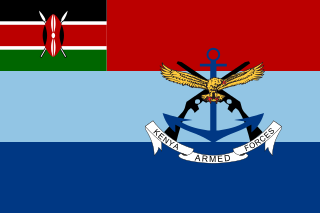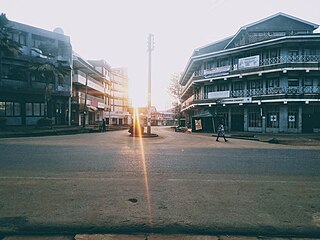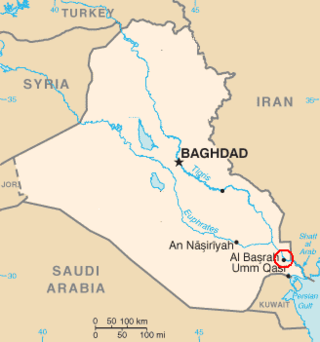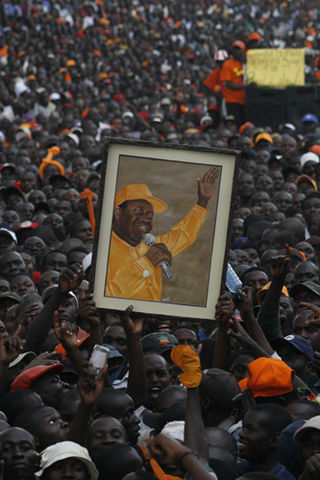Related Research Articles

The Kenya Defence Forces (KDF) are the armed forces of the Republic of Kenya. They are made up of the Kenya Army, Kenya Navy, and Kenya Air Force. The current KDF was established, and its composition stipulated, in Article 241 of the 2010 Constitution of Kenya; it is governed by the KDF Act of 2012. Its main mission is the defence and protection of the sovereignty and territorial integrity of Kenya, recruitment to the KDF is done on yearly basis. The President of Kenya is the commander-in-chief of the KDF, and the Chief of Defence Forces is the highest-ranking military officer, and the principal military adviser to the President of Kenya.

The United Self-Defenders of Colombia was a Colombian far-right paramilitary and drug trafficking group which was an active belligerent in the Colombian armed conflict during the period from 1997 to 2006. The AUC was responsible for retaliations against the FARC and ELN communist organization as well as numerous attacks against civilians beginning in 1997 with the Mapiripán massacre.

Mountain Elgon is an extinct shield volcano on the border of Uganda and Kenya, north of Kisumu and west of Kitale. The mountain's highest point, named "Wagagai", is located entirely within Uganda. Although there is no verifiable evidence of its earliest volcanic activity, geologists estimate that Mount Elgon is at least 24 million years old, making it the oldest extinct volcano in East Africa. The mountain's name originates from its Maasai name, Elgonyi.

Trans-Nzoia County is a county in the former Rift Valley Province, Kenya, located between the Nzoia River and Mount Elgon, 380 km northwest of Nairobi. At its centre is the town of Kitale which is the capital and largest town. The county borders Bungoma to the west, Uasin Gishu and Kakamega to the south, Elgeyo-Marakwet to the east, West Pokot to the north and the Republic of Uganda to the Northwest. Trans Nzoia covers an area of 2495.5 square kilometres.

OMON is a system of special police units within the National Guard of Russia. It previously operated within the structures of the Soviet and Russian Ministries of Internal Affairs (MVD). Originating as the special forces unit of the Soviet Militsiya in 1988, it has played major roles in several armed conflicts during and following the 1991 dissolution of the Soviet Union.

Bungoma is the capital of Bungoma County in Kenya. It was established as a trading centre in the early 20th century. It is located in Kenya's fertile Western region and at the foot of Mount Elgon, Kenya's second-tallest mountain. The town and the surrounding areas boast one of Kenya's highest average rainfalls, making Bungoma one of the nation's most important food baskets.
The Southern Nilotic languages are spoken mainly in western Kenya and northern Tanzania. They form a division of the larger Nilotic language family, along with the Western Nilotic languages and the Eastern Nilotic languages.
The Sebei are a Southern Nilotic ethnic group inhabiting western Kenya, eastern Uganda, Tanzania, Ethiopia, Sudan and Democratic Republic of the Congo. They speak Kupsabiny, a Kalenjin language. The Sapiiny occupy three districts, namely Bukwo, Kween and Kapchorwa in Uganda, Transnzoia county, Bungoma county and West Pokot county in Kenya

Mount Elgon National Park is a national park in Kenya and Uganda that lies 140 kilometres (87 mi) northeast of Lake Victoria. The park covers an area of 1,279 square kilometres (494 sq mi). The Ugandan part of the park covers 1,110 km2 (430 sq mi) while the Kenyan part covers 169 km2 (65 sq mi). The Kenyan part of the park was gazetted in 1968, the Ugandan part in 1992.
Mount Elgon District was an administrative district in the Western Province of Kenya. Its capital town was Kapsokwony. In 2010, it was merged into Bungoma County.
After two decades of violence and civil war and after the Transitional Federal Government (TFG) of Somalia captured Mogadishu and Kismayo, the TFG attempted to disarm the militias of the country in late 2006. According to the UN/World Bank's Joint Needs Assessment (JNA) coordination secretariat, "the total estimated number of militias [militia members] to be demobilized is 53,000." In 2005, they estimated that "there are 11–15,000 militia people controlling Mogadishu ."

The Myanmar Police Force, formerly the People's Police Force (ပြည်သူ့ရဲတပ်ဖွဲ့), is the law enforcement agency of Myanmar. It was established in 1964 as an independent department under the Ministry of Home Affairs.

The Battle of Basra began on 25 March 2008, when the Iraqi Army launched an operation to drive the Mahdi Army militia out of the southern Iraqi city of Basra. The operation was the first major operation to be planned and carried out by the Iraqi Army since the invasion of 2003.

The 2008 Iraq spring fighting was a series of clashes between the Mahdi Army and allies and the Iraqi Army supported by coalition forces, in southern Iraq and parts of Baghdad, that began with an Iraqi offensive in Basra.

The Mount Elgon insurgency was a conflict that started in 2005 when the Sabaot Land Defence Force militia revolted in the Mount Elgon area, Western Kenya.
justice Samwel Mukira Mohochi is a Kenyan [Judge] of the [High Court] human rights activist and attorney, with extensive legal experience on human rights litigation in national courts. He is an international human rights advocate before treaty monitoring bodies and the United Nations Human Rights Council.
Laboot is a settlement in Bungoma County, Kenya. The estimated population is 3621 as per 2019 population census, and the settlement lies at an elevation of 10,387 feet (3,166 m).

The Battle of Kismayo was an offensive led by the Kenya Defence Forces, under the codename Operation Sledge Hammer, to seize the port city of Kismayo, Somalia, from Al-Shabaab from 28 September 2012. Fighting alongside the Kenya Army were Raskamboni movement militia and the Somali Army.

Ethnic conflicts in Kenya occur frequently, although most are classified as minor skirmishes. A significant increase in the severity of such conflicts between the various ethnic groups inhabiting the country was witnessed after the introduction of multi-party politics in the early 1990s, especially during the 2007–08 Kenyan crisis. Major conflicts have also led to exoduses of ethnic minority communities with roots in other geographical areas.

The Sabaot are one of the nine sub-tribes of the Kalenjin of Kenya and Uganda. The Sabaot in turn are divided into six communities largely identified by their dialects. These dialects of the Sabaot language are the Pok, Somek, Mosop, Kony, Bong'omek and Sabiny. Being resident around Mount Elgon, the original homeland of most Kalenjin, the Sabaot are seen as the keepers of the authentic Kalenjin tradition. They and the area they inhabit are often referred to as Kapkugo by other Kalenjin.
References
- 1 2 "Kenya: Army and Rebel Militia Commit War Crimes in Mt. Elgon". Human Rights Watch. 3 April 2007.
- 1 2 3 Josphat Makori (11 February 2008). "Kenyan militia strike back". BBC News. Retrieved 4 January 2010.
- ↑ Stephanie McCrummen (11 March 2008). "Kenyan Troops Struck at Militia Involved in Land Clashes". The Washington Post.
- ↑ "Q&A: Kenya peace deal". BBC News. 13 April 2008. Retrieved 4 January 2010.
- 1 2 3 4 "Unreported World – 10/10 – Kenya's Human Time Bomb". Channel 4. 22 April 2008.
- 1 2 Amos Kareithi & Isaiah Lucheli (10 April 2007). "SLDF militia a force to reckon with". The Standard.
- ↑ Nina O'Farrell (16 April 2008). "George Bush's Aids relief plan is undermined by morality clauses". The Guardian.
- ↑ Robin Toner (5 February 1986). "Abortion battle shifts to aid for family planning". The New York Times.
- ↑ ISS 2010, 169-171
- ↑ "Kenya: Armed and dangerous – Kenya".
- ↑ Conversion from https://transferwise.com/gb/currency-converter/ugx-to-gbp-rate?amount=10000
- ↑ "Kenya MPs try to fast-track bills". BBC News. 11 March 2008. Retrieved 4 January 2010.
- ↑ Daily Nation, 25 May 2008: Droves of militia surrender Archived 28 May 2008 at the Wayback Machine